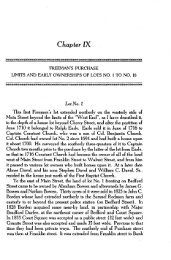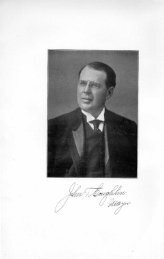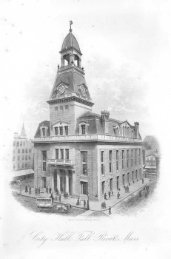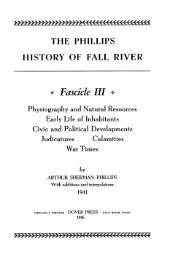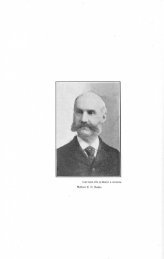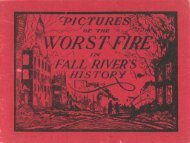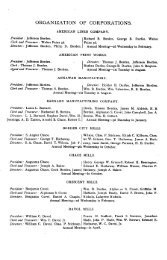Fall Rivers' Industries
Fall Rivers' Industries
Fall Rivers' Industries
Create successful ePaper yourself
Turn your PDF publications into a flip-book with our unique Google optimized e-Paper software.
78 HISTORY OF FALL RIVER<br />
had a capital of $120,000, afterwards increased<br />
to $200,000, and in 1870 containe d<br />
14,448 spindles and 354 looms. It was<br />
burned Nov. 2, 1875, and was not rebuilt .<br />
The site, as well as that of the Massasoit<br />
flour mill, formerly Chase, Nason & Durfee ,<br />
is now occupied by the Massasoit Mfg. Co .<br />
The old mill on Pocasset street was operate d<br />
for a time as a cotton mill under the agency<br />
of Linden Cook, by a corporation know n<br />
as the Wahtahpee mills (the old spelling o f<br />
Watuppa) and eventually became a part o f<br />
the Pocasset Company .<br />
The Quequechan mill, also erected by th e<br />
parent company, was a part of Robeson's<br />
<strong>Fall</strong> River Print Works until 1859, whe n<br />
6,000 spindles were placed in it and cotto n<br />
manufacture begun. The capacity wa s<br />
gradually increased to 12,800 in 1867 . After<br />
the failure of the print works the mill wa s<br />
operated for the creditors with Andre w<br />
Robeson, third, manager, until 1879, when a<br />
corporation called the Quequechan mill s<br />
was organized with Mr . Robeson treasurer .<br />
He resigned in 1881 and was succeeded b y<br />
D. H. Dyer. The business proved unprofitable<br />
and after a time the mill was sold an d<br />
devoted to other purposes .<br />
The Anawan Manufactory, which stoo d<br />
over the stream, where the <strong>Fall</strong> River Iron<br />
Works No. 7 mill now is, was erected by th e<br />
Iron Works interests in 1825, though as a<br />
separate corporation. It was a large factor y<br />
in its day, with 10,000 spindles, and wa s<br />
notable for the hammered granite block s<br />
used in its lower stories, which were utilized<br />
in the building of the new mill whe n<br />
the old was razed in 1905 . Like the Meta -<br />
comet it was run by the Iron Works under<br />
the direction of Major Bradford Durfee ,<br />
Foster Stafford and Richard B . Borden, unti l<br />
the division of the property in 1880 .<br />
Thomas S. Borden and W. Frank Shove<br />
have been recent treasurers of the corporations,<br />
with Jefferson Borden and John S .<br />
Brayton, presidents . The Anawan discontinued<br />
operations in the late 90's .<br />
The Wampanoag mills were organized i n<br />
1871, with Robert T. Davis, president ;<br />
Walter C. Durfee, treasurer ; and R. T .<br />
Davis, W . C. Durfee, John D. Flint, Stephe n<br />
Davol, Foster A. Stafford, Simeon Borden ,<br />
George H. Eddy, Alphonso S . Covel, Lloy d<br />
S. Earle, William H. Jennings and .John H .<br />
Boone directors. The first mill was o f<br />
granite, 298x74, five stories high, with 28,00 0<br />
spindles. Number 2, also of granite, fiv e<br />
stories high, 328x74, was erected in 1877 . and<br />
a weave shed, 215x96, two stories in height ,<br />
built in 1887 . The original capital of $400 ,<br />
000 was increased to $500,000 in 1877 and t o<br />
$750,000 in 1887. The plant now has 14,85 2<br />
mule and 70,336 frame spindles, and 2,21 5<br />
looms, of which 1,547 are more than 32 inch -<br />
es wide. It has a weekly production of 12, -<br />
000 pieces. Mr. Davis is still president.<br />
Walter C . Durfee was treasurer till 1891 ,<br />
when he was succeeded by Effingham C .<br />
Haight, followed by William Evans in 190 1<br />
and by W. Frank Shove in 1905 . The directors<br />
are Robert T . Davis, John D. Flint, Geo.<br />
H. Eddy, Franklin L. Almy, John H . Boone ,<br />
Wm. H. Jennings, Robert C . Davis and W .<br />
F. Shove. Jas. O. Thompson, Jr., is superintendent<br />
.<br />
The Stafford mills were organized in 1871 ,<br />
with a capital of $550,000, increased in 188 8<br />
to $800,000 and in 1896 to $1,000,000 . Foster<br />
H. Stafford was the first president an d<br />
agent, with Shubael P. Lovell treasurer an d<br />
F. H. Stafford, Samuel Hathaway, Charles P .<br />
Stickney, Robert T . Davis, William C . Davol ,<br />
William L. Slade, Danforth Horton, Edmund<br />
Chase and Weaver Osborn directors .<br />
The first mill was of five stories, granite ,<br />
374x70, and was followed in 1886 by a second<br />
of the same material and dimensions .<br />
A weave shed, 173x160, was erected in 1900 .<br />
The plant has 100,576 frame spindles and<br />
2,617 looms, of which 791 are more than 3 2<br />
inches wide. It employs 825 hands and ha s<br />
a weekly production of 14,000 pieces . Foste r<br />
H. Stafford, the first president, died in 1891 ,<br />
and was succeeded by Robert T . Davis. The<br />
treasurers have been : S. P. Lovell, 1871 -<br />
82 ; Albert E. Bosworth, 1882-88 ; Effingha m<br />
C. Haight, 1888-90; Frank W. Brightman ,<br />
1890-1901 ; Fred E . Waterman since 1901 .<br />
The directors are Robert T . Davis, Robert<br />
Henry, John C . Milne, Edward E. Hathaway ,<br />
Samuel W. Hathaway, Charles B. Luther an d<br />
Fred E. Waterman. The superintendent i s<br />
Timothy Sullivan .<br />
The American Linen Company was incorporated<br />
in 1852 as the American Linen Manufacturing<br />
Company, with a capital of $350<br />
. Colonel Richard Borden, Jefferson Bor,000 -<br />
den, Oliver S. Hawes and Lazarus Borde n<br />
were the chief promoters of the enterprise ,<br />
which was started for the manufacture of<br />
fine linen fabrics. Large store building s<br />
were erected, including a mill 301x63, bu t<br />
the demand for the product soon fell off ,<br />
because of the introduction of thin woolen<br />
and cotton cloths, which could be purchase d<br />
at less cost, and in 1858 the machinery was




